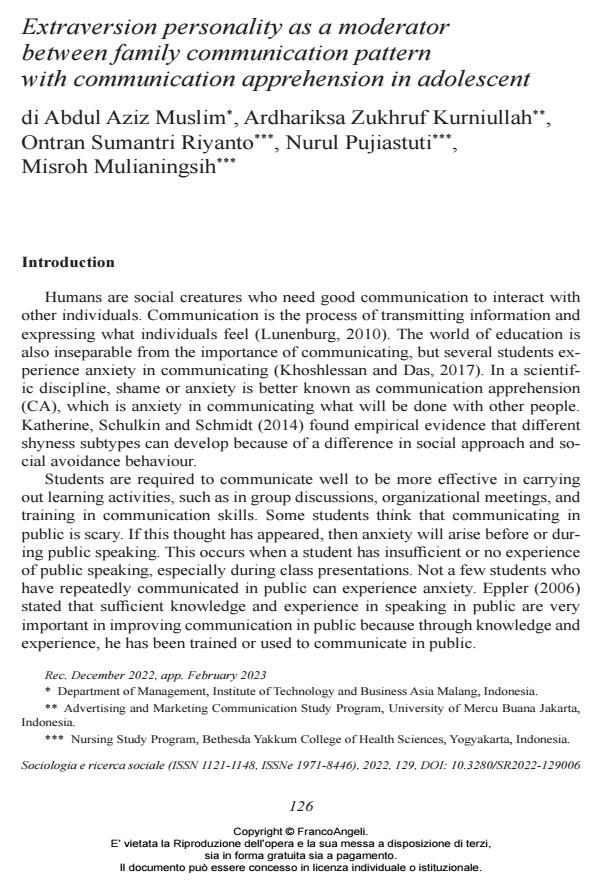Extraversion personality as a moderator between family communication pattern with communication apprehension in adolescent
Titolo Rivista SOCIOLOGIA E RICERCA SOCIALE
Autori/Curatori Abdul Aziz Muslim, Ardhariksa Zukhruf Kurniullah, Ontran Sumantri Riyanto, Nurul Pujiastuti, Misroh Mulianingsih
Anno di pubblicazione 2023 Fascicolo 2022/129
Lingua Inglese Numero pagine 10 P. 126-135 Dimensione file 158 KB
DOI 10.3280/SR2022-129006
Il DOI è il codice a barre della proprietà intellettuale: per saperne di più
clicca qui
Qui sotto puoi vedere in anteprima la prima pagina di questo articolo.
Se questo articolo ti interessa, lo puoi acquistare (e scaricare in formato pdf) seguendo le facili indicazioni per acquistare il download credit. Acquista Download Credits per scaricare questo Articolo in formato PDF

FrancoAngeli è membro della Publishers International Linking Association, Inc (PILA)associazione indipendente e non profit per facilitare (attraverso i servizi tecnologici implementati da CrossRef.org) l’accesso degli studiosi ai contenuti digitali nelle pubblicazioni professionali e scientifiche
Humans are social creatures who need good communication to interact with other individuals. This study aims to understand the influence of family communication patterns (conversation and conformity) on communication apprehension moderated by the adolescent’s extraversion personality. An instrument is the Personal Report of Communication Apprehension (PRCA-24), Revised Family Communication Patterns Instrument (RFCP), and International Personality Item Pool (IPIP) NEO-120. The result showed that pattern of conversation has a negative effect (ß = -0.620, p = 0.000) and conformity has a positive effect (ß = 0.730, p = 0.008) on communication apprehension. Conversation orientation is a relationship between family members who emphasize freedom in expressing an opinion. Meanwhile, the application of conformity family communication patterns is more oriented toward children’s independence. Extraversion personality can decrease the influence of the communication patterns conversation and conformity to communication apprehension. Communication apprehension moderated by extraversion personality in the adolescent is influenced by the application of the conformity family communication pattern.
- Comparative Analysis of Regulations on IT-Based Money Lending and Borrowing Services in Indonesia and Vietnam Sri Mulyani, Le Ho Trung Hieu, Anggraeni Endah Kusumaningrum, Retno Mawarini Sukmariningsih, Ontran Sumantri Riyanto, in WSEAS TRANSACTIONS ON ENVIRONMENT AND DEVELOPMENT 66/2024 pp.689
DOI: 10.37394/232015.2024.20.66
Abdul Aziz Muslim, Ardhariksa Zukhruf Kurniullah, Ontran Sumantri Riyanto, Nurul Pujiastuti, Misroh Mulianingsih, Extraversion personality as a moderator between family communication pattern with communication apprehension in adolescent in "SOCIOLOGIA E RICERCA SOCIALE " 129/2022, pp 126-135, DOI: 10.3280/SR2022-129006